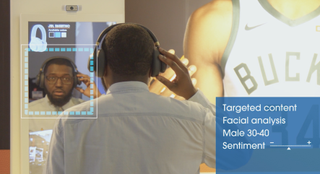With advanced algorithms that can quickly crunch vast quantities of data to execute tasks, artificial intelligence (AI) is driving the next generation of consumer and commercial technologies. From home media interfaces like Amazon Alexa to manufacturing plants driven by machine learning, AI is making integrated systems smarter.
Tractica forecasts that the total global revenue for AI software will grow from $9.5 billion in 2019 to as much as $118.6 billion in 2025.
Within the ever-evolving field of AI and biometric technologies are facial detection and facial recognition. Between 2014 and 2018, facial recognition software became “20 times better at searching a database to find a matching photograph,” according to a National Institute of Standards and Technology (NIST) evaluation of 127 software algorithms from 39 different developers.
As facial capture, detection, and recognition technologies improve, the value proposition is becoming clear to stakeholders in digital signage, control, and other corners of the AV ecosystem. Samsung, Intel, KanduAI, and many other vendors demonstrated AI-powered solutions at InfoComm, ISE, and DSE in 2019. CyberLink, for example, showed its FaceMe AI facial recognition engine at DSE. Another player in the emerging field, KanduAI describes its mission as bringing “artificial intelligence to everyday devices,” making it possible to perform artificial intelligence computing on low-cost and low-power edge devices such as smartphones, security cameras, IoT sensors, and more.
As AI-enabled AV options proliferate, it’s useful to understand the difference between facial detection and facial recognition. It’s also critical to understand the legal realities of these emerging technologies.
Facial Detection Versus Recognition
Generally explained, facial detection software can detect a human face in the context of videos and images. Using data sets based on a specific person’s facial details and features, a matching process can analyze patterns, and identify/verify if two faces belong to the same person. This leads to facial recognition.
ELAN’s senior director of marketing, Bill Hensley, describes facial detection “as identifying the presence of a person’s face (or multiple persons) in the camera view, whereas facial recognition is identifying which person’s face it is.”
The solutions ELAN is developing that can apply to the pro AV market use face recognition.
Joseph Warner, senior technical account manager, Samsung SDS America, shared a different perspective. “The Samsung Nexshop analytics solution doesn’t use facial recognition. We use PII-compliant facial analysis,” said Warner, using the acronym PII to refer to personally identifiable information. “This means the algorithm analyzes the facial features and assigns a code—e.g., male, female, age range. We never attribute this information to a specific person.”
Not at Scale (Yet)
For years, AI has been used to enhance the feature sets of surveillance camera networks, CCTV cameras for traffic analysis, and smart kiosks used in hospitality applications. Facial detection, object recognition, and movement detection are informing smarter AV systems, such as lecture capture based on auto-tracking PTZ cameras. But is facial recognition being used at scale in office settings?
Jason Goecke, vice president and general manager of Intel Unite at Intel, says that concrete requests for facial recognition at the enterprise level are growing. “There is value in [facial recognition] for a myriad of use cases,” Goecke said, “and we are seeing direct requests for it. But I’d say it’s still in its relatively early stages as to how it’s getting rolled out—at scale—within various enterprises.”
Deliver Targeted Content
Samsung SDS PII-compliant facial analysis is automating a standard process that has been used for years to better understand customers. Samsung integrates its analytics solution with digital signage solutions, as well as audio, video, and lighting.

Warner explained, “Retailers are able to deliver targeted content based on the anonymous data collected, and incorporate demographic, timeframe, and weather data into AI engines that can improve customer experience, a brand’s products, and overall store environments.”
Brands and retailers who can act on this information successfully may “gain a lift in sales by showcasing the products and content tailored to the PII-compliant audience data,” he added.
Personalizing the Control Experience
While the use of AI-enabled digital signage is established in retail, and increasingly common in transportation, facial recognition in pro AV control is relatively new. The team at ELAN sees facial recognition as a valuable way to “personalize the control experience” and add to the system’s ease-of-use, said Hensley.
For example, in a restaurant or sports bar where everyone on the waitstaff has a profile saved in the ELAN system, each profile enables a particular subset of control, such as adjusting the media playing in particular rooms. This could be the music, video, or a combination of both. The same profile could also enable the control of lighting or temperature in rooms assigned to that person.
If a member of the waitstaff approaches the ELAN Intelligent Touch Panel, it recognizes his or her face and presents their personalized (limited) set of controls. For management, positive facial recognition could unlock access to protected parts of the network such as global AV settings or the surveillance system, or physical locations such as the management office or wine cellar.
What’s more, if a customer approaches the Intelligent Touch Panel, nothing happens, Hensley said, because “their face has not been purposefully learned into the system. It is important to note that the system is not randomly learning or storing faces. It must be directed to do so by someone with admin access.”
Legal Realities of Facial Detection and Recognition
Samsung SDS’ Warner said that “no personal customer information is collected by the Nexshop sensors, so privacy is not a concern. The data is aggregated and anonymized, so individual information is not collected or stored. Bodies, faces, and other moving objects are assigned identification numbers for their duration within the sensor range.”
Local ordinances and privacy laws must be observed. According to ELAN’s Hensley, “It’s essential to know the laws in your jurisdiction and how they apply to face recognition and other biometric technologies.”
Compliance, Regulations, and Privacy
There are a bevy of laws, like the EU General Data Protection Regulation (GDPR), that govern how data is handled. AV professionals must understand how regulations like the GDPR influence organizations and procedures in California and across the globe—not just in the European Union.
Goecke underscored the importance of aligning “corporate IT policies and privacy policies.” Vendors need to collaborate with customers, large and small, to understand best practices in this emerging field. From a biometric protection and privacy perspective, he explained, walking into a room and the system knows you are there is a very different situation from walking into a room and the system knows who you are.
Many large companies may have compliance policies in place, but all organizations need to understand how data transparency and image consent apply to their business. Some corporate policies state their method of data retention and have their workforce sign off on it. Technology and HR leaders must learn when and how GDPR and similar regulations apply, because most companies have third parties (non-employees) interfacing with the AV, UCC, and media in their conference rooms, lobbies, and social spaces.
It’s also notable that many people do not want their faces or identities recorded, scanned via camera, or stored in a database. There are growing concerns about face capture and the sale of that correlating data without consent or knowledge. A guest to an event or symposium held at an enterprise could potentially say, “I don’t want to be seen on any of your systems.”
Bottom line: Integrators should not leave compliance or privacy concerns to chance. Research all germane laws. Consider AI-enabled AV solutions that will allow compliance with regulations, like GDPR, in appropriate jurisdictions. However, in our ever-expanding, digitally connected business landscape, local jurisdictions may also mean global, over time.














